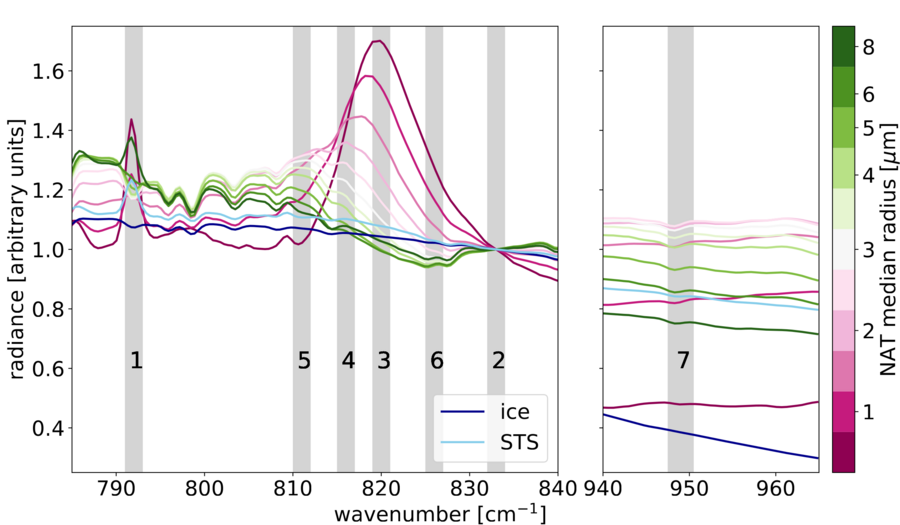CRISTA-NF - a Helium-cooled Infrared Telescope for the Atmosphere
PSC observations
Polar stratospheric clouds are a special type of clouds that can form at low temperatures in the stratosphere. The right conditions for the formation are typically present in the polar vortex in winter time. PSCs are subdivided into three types: 1. NAT (Nitric acid trihydrate; crystalline particles consisting of water and nitric acid), 2. STS (supercooled ternary solution; droplets consisting of water, nitric acid, and sulfuric acid), and 3. ice. Polar stratospheric clouds have a large influence on the ozon chemistry inside the polar vortex for two reasons. First, the activation of chlorine from its reservoir species occurs on cold surfaces. These surfaces are provided by the cold cloud particles. The active chlorine then destroys ozone in catalytic cycles. Second, subsiding NAT particles lead to a downward transport of HNO3 in the atmosphere. In denitrified air masses the chlorine deactivation is slowed down, which leads to an extension of the ozone destruction and, thus, to a larger ozone loss.
PSCs are observed by different techniques, whereby LIDAR observations and the in-situ measurements using optical particle sensors are very common. Besides these types of instruments, infrared limb emission sounder such as CRISTA-NF are also able to detect clouds are in the case of PSCs they are also able to distinguish different types of PSCs. This was achieved by the CRISTA (LINK) instrument for the first time. The distinction of the PSC types is based on different spectral characteristics for the different particle types. Small NAT particles, for example, cause a unique spectral peak at about 820 cm-1.

Figure 1: Spectral signatures of the different PSC particle types derived from simulations. Spectra simulated for NAT particles are shown in purple and green, spectra for STS in light blue, and spectra for ice in dark blue. The figure is taken from Kalicinsky et al. (2021).
Read more about
During the RECONCILE aircraft campaign (LINK) CRISTA-NF observed a very similar feature, but the peak was slightly shifted towards smaller wavenumbers comperd to the original peak. Simulations showed that the appearance of the spectral feature depends on the size of the NAT particles (compare Fig. 1). The feature transforms from a peak at 820 cm-1 to a shifted peak and finally to a step like feature with increasing particle size. Based on this relationship between size and appearance it was possible to improve the NAT detection and to perform a size distinction for the first time. We developed a method to distinguish three different size ranges of NAT particles: sNAT (small NAT; radius ≤ 1 µm), mNAT (medium NAT; radius 1.5 – 4 µm) und lNAT (large NAT; radius ≥ 3.5 µm).

Figure 2: CRISTA-NF observation inside of the polar vortex during RECOCILE. The flight altitude is shown a black curve. left: Cloud index as a measure of optical thickness. Low values indicate clouds. right: Determination of the PSC particle types inside the cloud. The cloud bottom is located between the purple and the green curve. The figure is taken from Kalicinsky et al. (2021).
Read more about
During the aircraft campaign the M55-Geophysica aircraft crossed PSCs in five flights. Figure 2 shows the flight from January 22 2010 as example. During this flight mainly medium sized NAT particles (1.5 – 4.0 µm) and STS were observed. Further details and information are given in Kalicinsky et al. (2021) (LINK).
At the moment the method is transferred to the MIPAS-Env satellite instrument, which provides more than 10 years of observations in both polar regions.
